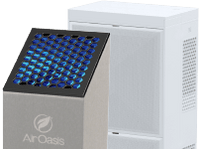Keeping The Air Clean: A Guide to Air Pollution
Air pollution is a serious issue that affects not just Americans, but people living in countries across the globe. While not new, it has reached a level that puts human and animal life at risk, and threatens the environment. Air pollution occurs when harmful foreign substances, generally gases and particulates, are introduced into the air and reach harmful levels. This can occur both outdoors and indoors. The most common and dangerous air pollutants are ozone, particulate matter, carbon monoxide, lead, sulfur dioxide, and nitrogen oxide. While an air purifier or air sanitizer can temporarily cleanse indoor air of some of its pollutants, it is far more difficult and complicated to resolve the problem of outdoor air pollutants. A successful campaign against air pollution involves the mutual participation of governments and citizens from nations worldwide.
Causes
Air pollution is caused by a number of both human and nature-based sources. Much of the world’s pollution comes from the emissions of planes, automobiles, ships, power plants, and other human activities that involve the burning of fossil fuels. The smoking of tobacco and the past use of products containing chlorofluorocarbons, such as hair spray and other aerosols have also been contributing factors. Pesticides are also a problem, as they may be stirred up and rise into the air during windstorms or during the application process. Nature is also a recurring cause of pollutants in the air. Gases such as methane and ammonia are regularly released from the manure of livestock and from swampy regions. Wildfires and volcanic eruptions are also ways in which pollution gets into the air. Common causes of indoor pollution include lead, the burning of kerosene, wood-burning stoves, tobacco products, dust and more.
- Pollution
- What is the Cause of Most Air Pollutants?
- What is the Cause of Air Pollution? Do Animals and Plants Also Pollute the Air?
- Causes and Sources of Indoor Air Pollutants
Effects
The dangerous effects of air pollution are almost innumerable. Carbon dioxide is a greenhouse gas and excess amounts can not only cause global warming but also raise the acid levels of oceans. Carbon monoxide can deprive tissues in the body of oxygen by displacing it and can lead to death if a person is exposed to large amounts of it. Lead is damaging to a person’s nervous system and has the ability to negatively impact brain and kidney function. Particulate matter is an umbrella term for the many types of particles emitted by various pollution sources, some of which can cause irregular heartbeat, lung cancer, and respiratory illnesses, including asthma. Sulfur dioxide can worsen asthma and also lead to acid rain, which can harm plant and animal life. Asbestos is a serious lung cancer risk. Long term exposure to tobacco smoke, including second-hand smoke, results in an increased likelihood of heart disease, lung cancer, and respiratory illnesses, including bronchitis and pneumonia in the case of children.
- Gasping for Air: Toxic Pollutants Continue to Make Millions Sick and Shorten Lives (PDF)
- Air Pollutants Linked To Higher Risk Of Birth Defects, Researchers Find
- Indoor Air Pollution and Health
- Overall Health Effects
- Particle Pollution and Your Health
Solutions
The most effective solution for air pollution is prevention. In the case of outdoor air pollution, people can make conscious decisions to reduce or eliminate personal activities that contribute to the problem. This includes altering their driving habits by consolidating driving trips, joining a carpool to work, bicycling, or riding public transit. When driving one’s car, never top off the gas when filling up, and keep the car well-maintained. Changing the vehicle’s air filter, inflating tires properly, and driving at the legal speed limit are all actions that will ultimately help reduce the amount of pollution in the air. If possible, drivers may consider switching from gasoline-powered cars to electric ones. At home, switch to an electric lawn mower, or even a traditional push-powered one. Conserving electricity and recycling products instead of throwing them away also reduces the need for factory and power plant activity. Governments should be encouraged to continue addressing and researching air pollution solutions such as renewable energy sources and technologies. In addition, they must also continue to create laws that further help regulate toxic emissions.
To fight both outdoor and indoor pollution, stop smoking or don't start. Preventive measures are important when it comes to indoor air pollution. Looking for and repairing leaks in pipes and faucets can help to reduce mold development. Using environmentally friendly cleaners will help to reduce volatile chemicals released in the air. Vacuum cleaners that use HEPA filters can help by cutting the amount of dust that is produced while vacuuming. One may want to also purchase an air purifier, which can help to reduce indoor pollutants around the home, or an air sanitizer, which can kill a large amount of bacteria in the air and cut odors.
Facts
According to the American Lung Association’s State of the Air, ozone and particle pollution are the two dominant air pollutants in the United States. On average, a person living in the United States breathes as much as 3,000 gallons of air on a daily basis. More than half of the United States population lives in areas with ozone and particle pollution levels that are at unhealthy levels. For people who live in these areas, the risk of heart disease is increased, as is the risk of lung cancer. Individuals who work outdoors and people who exercise outside have a greater risk of illness from pollution in the air. According to the carbon monoxide emissions that pollute the air in the U.S., 60 percent of it is produced by vehicle exhaust. According to the EPA, one of the five environmental health risks faced by the public is poor indoor air quality. Lowering the amount of air pollution would also lower the risk of both long- and short-term cardiovascular and respiratory health problems.

